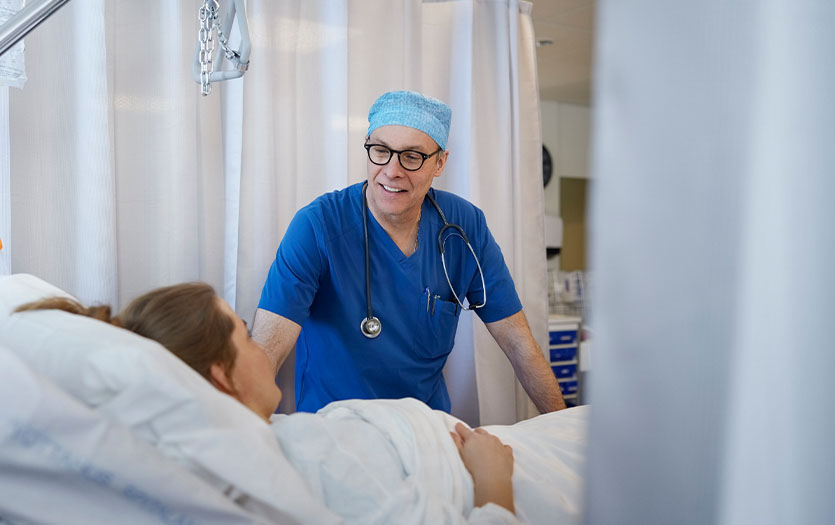
This post was written by Dr. Jose Parodi, PPG – General Surgery, Parkview Bryan Hospital.
Most hernias are not life-threatening, but some can become serious over time if left untreated. Repairing the weakened abdominal wall muscles typically involves surgical intervention. In this post, we'll examine how robotic surgery enhances hernia care, as well as additional considerations for patients preparing for the procedure.
What makes robotic hernia surgery different than other methods?
Robotic hernia surgery differs from traditional open or laparoscopic surgery in many ways. Robotic hernia surgery is a minimally invasive procedure that utilizes an engineered robotic system controlled by the surgeon's hands, coupled with a 3D viewer computer platform system. It provides a high-quality view of the hernia anatomy. This image is critical in reducing the risk of intraoperative complications, particularly when working around blood vessels, muscles and nerves.
Robotic surgery offers surgeons greater dexterity, with an expanded range of motion and enhanced wrist capabilities, making it ideal for suturing or anchoring fabric or mesh during hernia repair.
Besides supporting the surgeon, this option benefits the patient in the following ways:
-
Smaller incisions (about ¼-½ inch long) compared to open hernia repair (about 8-10 inch incision) reduce the risk of surgical site infections.
-
More cosmetically appealing results and minimal blood loss.
-
Minimal pain and prompt return to work, physical activity and fitness compared to an open surgery.
Who is a good candidate for robotic hernia surgery?
Patients must undergo a consultation with a surgeon to determine their eligibility for the procedure. In general, this approach may be recommended for:
-
Patients with small to medium-sized hernias
-
Patients with recurrent or complex hernias
-
Patients seeking a fast recovery process
-
Patients with multiple hernias
-
Overweight and obese patients. Flexibility and enhanced vision of the robot make hernia repair easier for patients with a high body mass index (BMI).
However, not every patient will be eligible for robotic hernia repair. In some cases, alternative treatment options may be more suitable, including for:
-
Patients who cannot undergo general anesthesia.
-
Patients with certain medical conditions, such as severe heart failure or chronic lung disease.
-
Patients with the presence of intra-abdominal scar tissue or adhesions. However, this may not completely rule out surgery but may increase the risk of complications depending on the patient's age and other contraindications.
-
Patients who have very large hernias or who have lost part of the abdominal wall might be better suited for an open abdominal wall reconstruction than robotic surgery.
What should a patient consider when preparing for robotic surgery?
Preparing for robotic surgery involves several important considerations to ensure a smooth procedure and recovery. Here are some key factors to keep in mind:
Surgical consultation
-
Understand the specifics of the procedure, including benefits, risks and alternatives.
-
Discuss the expected outcomes and potential complications associated with the procedure.
Medical and preoperative evaluation
-
Ensure that you have completed all necessary preoperative tests, such as an EKG, blood work, or any imaging that your provider has ordered.
-
Inform your care team about the medications (particularly blood thinners) or supplements you take, as well as any allergies or sensitivities you have. You may need to stop taking some medications before surgery.
-
Address any underlying conditions like diabetes or hypertension. Some patients may also require a preoperative cardiac risk assessment to minimize post-surgical risks.
Lifestyle and diet adjustments before and after robotic surgery.
-
Follow preoperative enhanced recovery guidelines, which often include no food or drink after midnight before surgery.
-
Maintain healthy dietary habits leading up to surgery, including following a high-fiber diet, to promote better healing and minimize postoperative constipation.
-
Avoid alcohol and tobacco, as they can impair wound healing and recovery.
Preparing for recovery after robotic surgery
-
Arrange for transportation home after surgery. Most robotic hernia surgeries are done on an outpatient basis. You may drive in 2-3 days and return to work in 3-7 days, depending on the type of hernia and work environment.
-
Set up a comfortable recovery space. You can sit with your feet elevated in a recliner or on a sofa during the day and sleep in a bed at night, with easy access to essentials.
-
Follow the postoperative care instructions, including restrictions and wound care, as highlighted by your care team at discharge.
Mental and emotional preparation before, during and after surgery
-
Understand that robotic surgery often leads to quicker recovery, less postoperative pain, cosmetically appealing results and prompt return to work and activity, but still requires healing time.
-
Manage anxiety by discussing concerns with your care team or seeking support.
-
Plan for work and activity restrictions or modifications post-surgery.
Final thoughts
At the Parkview Center for Robotic Surgery, our physicians are specially trained in the da Vinci Robotic Surgical System. If you are considering hernia repair surgery but are unsure where to start, consult with your primary care provider about your options. You can also learn more about minimally invasive robotic treatments for hernia and other conditions here.



